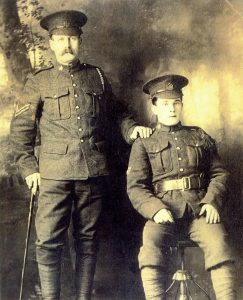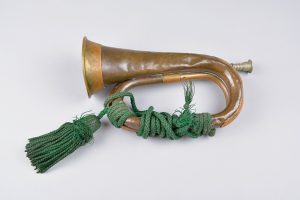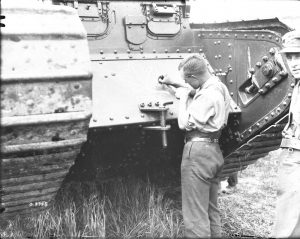Bugles, Boulders and Beams: Military Inscription as Memorial
A Tenacious and Persistent Soldier
Many young Canadian men desired to lend themselves to Canada’s war efforts. They saw a role for themselves within the country’s military conflicts overseas. Some were very eager to play a role in fighting on behalf of what they understood to be a noble cause. This meant they became eyewitnesses to important military conflicts.
Richard Walter Mills was born in Stratford, England in 1899 and came to Moose Jaw with his parents in 1907. In 1916, after lying about his age, he joined the 46th Battalion out of Moose Jaw. The army transferred to the 128th Battalion and he went overseas to battle.
While there, the army discovered his real age. Immediately, they returned him to England. After his 18th birthday, they permitted him to rejoin the army.
A Bugle Entrusted
When he enlisted, the army issued Mills a brass bugle with a green lanyard as part of his standard First World War kit. It became a constant presence amidst Mills’ entire war experience.
As all bugles of this type, it an important part in the communication between commanders and troops. He carried it during all the years of his service and it was present during his participation in battles. He carried it to Vimy Ridge, Lens, Hill 70, Passchendaele and Arras. These battles were intense and threatening and hold great significance with regards to Canada’s part in world conflict.
A Bugle Engraved with History
Upon surviving each of these harrowing experiences, Mills would inscribe these battles onto the outer surface of the instrument.
The activity of engraving the bugle personalized a standard and universal military issue. It doing so, it transformed the bugle into a meaningful record of war. This simple act of inscribing these battles memorialized Mills’ own experience and recorded the efforts of his entire battalion.
Inscriptions on Boulders
Richard Mills’ practice of inscription fits within a much broader military practice of inscription. It connects to the practice of inscribing a battle name on various other elements of a soldier’s kit. It also connects with the practice of the inscription of one’s name in a large stone before a battle. During the Boer war, for example, Canadian soldiers recorded their names on a boulder. Sometimes these types of inscriptions even took the form of images like a soldier’s profile image. For example, there is a self-portrait of Sergeant J. Perry, who was part of the Royal Canadian Regiment’s ‘C’ Company on such a boulder.
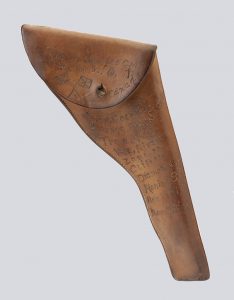
This holster was carried by J. M. Barker of the 2nd Canadian Mounted Rifles during the Boer War. Leather, 40.0 x 19.0 x 3.0 am.
Inscriptions in Masonry and in Chalk on Tunnels
Many Canadians wrote or carved personal information on the exterior of masonry. They would carve either their names, service numbers or regimental crests. Their inscriptions inhabit the walls of buildings near significant First World War battlefields. These inscriptions remain to this day on surviving churches and other buildings.
Soldiers also carved in the chalk of the tunnels under the battlefields of Vimy in 1917. One can only assume they were writing their names in places they would not imagine would survive the war. These soldiers probably assumed others would never actually see these records. Despite this, they likely wanted to indicate they were there and they were alive.
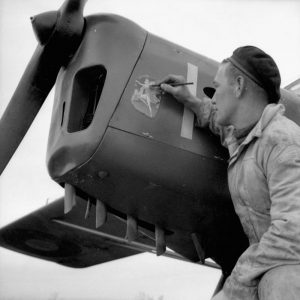
Leading Aircraftsman Robert Ducroq touching up “Jane” the nose art of an Auster aircraft in Orsogna, Italy in February of 1944.
The Poignancy of Inscription
The particular practice of inscription at Vimy is poignant in many ways. Stone is not only the material of buildings and tunnels. It is also the material of memorials and headstones. Many of the names written underground at Vimy were also later inscribed on the Vimy memorial. This is a haunting fact.
The Tradition of Inscription Endures
A century later, a wooden beam is now touring Canada. Taken from a Canadian bunker in Panjwai, Afghanistan, it commemorates the end of the Canadian mission in Afghanistan. Many soldiers who served in this conflict inscribed their signatures on it. These inscriptions have made it a significant and personal artifact of conflict.
Along with the signatures, a poem is also inscribed. Written by a Canadian soldier, it memorializes the death of Private Terry Street. The poem reads: “We left our homes and all we held dear/To come and fight and meet our death/And remind the world lest you forget/That honour and courage are not just words/But ways of life we proudly served.”
In a way, this poem is universal. Any soldier could write this. Any soldier could have this written about them. It could be about the soldiers who scratched into the rocks on a lonely hilltop in South Africa. It could be about the soldiers who carved into the chalk tunnels of Vimy.
The Enduring Physical Memory of Soldiers’ Presence
The history of inscription means that many objects and structures memorialize Canadian soldiers. These objects and structures throughout the world remain proof of soldiers’ historical presence. They are witness to the fact that soldiers sent to remote places by the politicians of their day. And, even if people fail to remember the reason these inscriptions are there, they ensure that people will at least remember their names.
If you would like to see more trench art and other Canadian war-related craft, click here.


